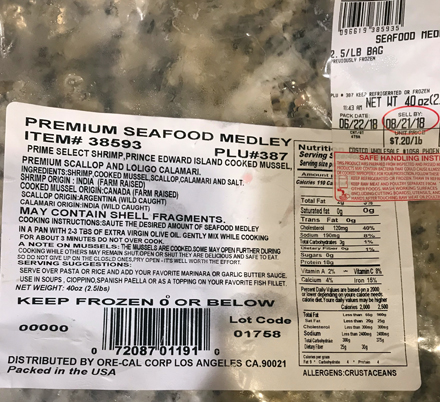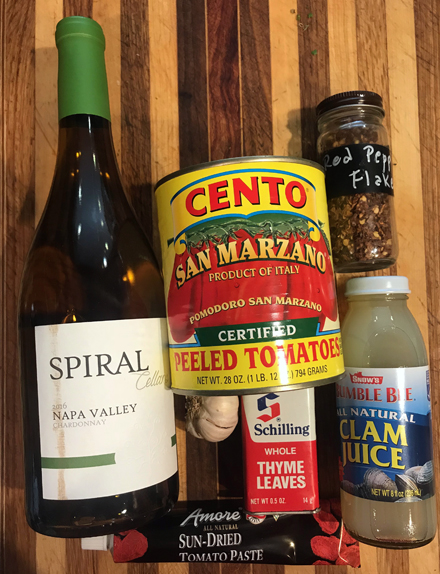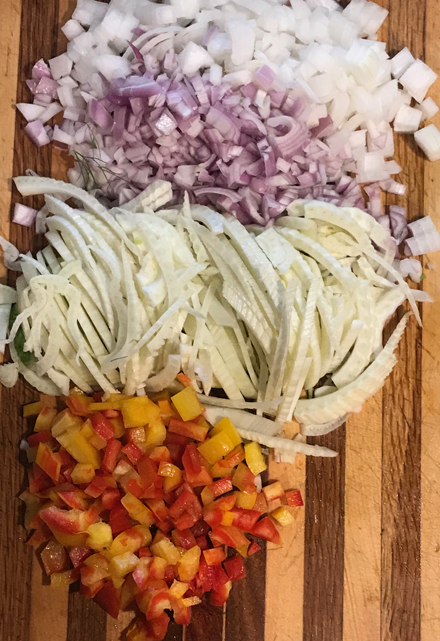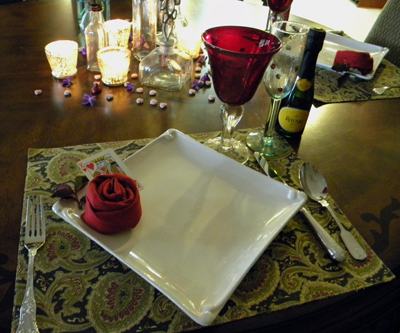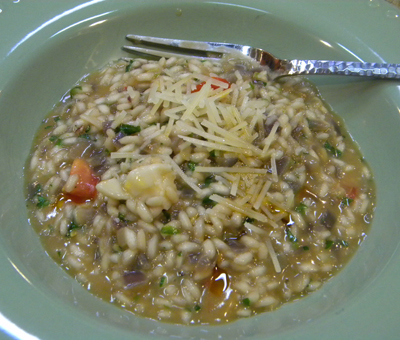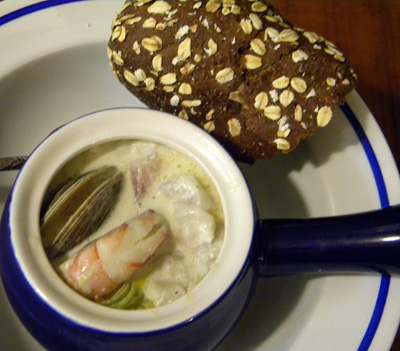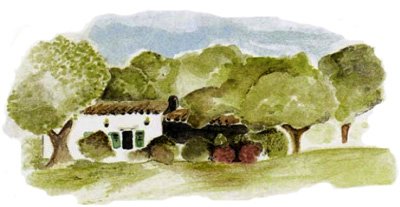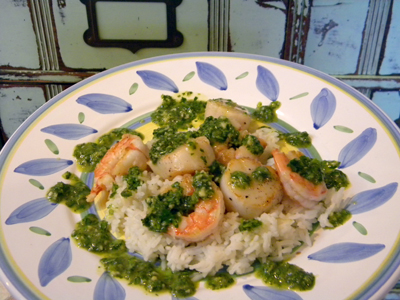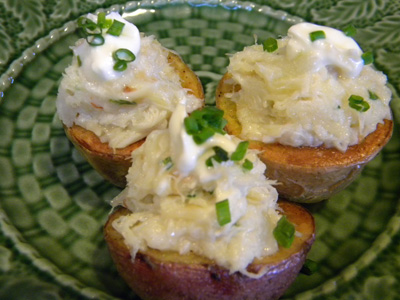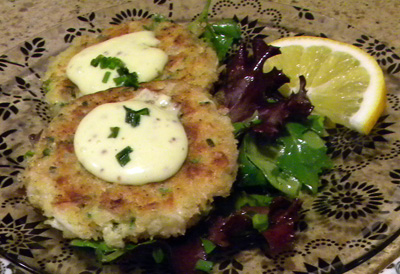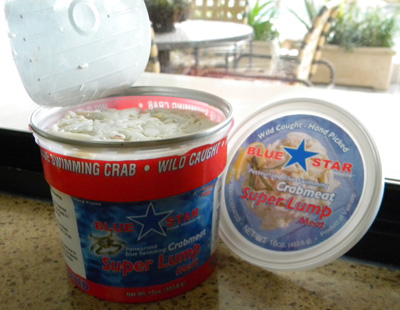Cioppino
Cioppino is a fish stew that was created in San Francisco in the late 1800s. It is traditionally made from the catch of the day, which in San Francisco is typically a combination of crab, clams, shrimp, scallops, squid, mussels, and fish from the Pacific ocean.
The Cioppino I served yesterday at Sunday supper for Connor, my dad, and myself was a seafood medley that came in this bag from Costco. It consisted of shrimp, mussels, scallops, and calamari rings.
Not only did it not come from San Francisco, but according to the packaging, that I am just now reading, none of it even came from the USA! Oh well, it tasted great and since it was frozen, it didn’t really matter.
Since you may be using live mussels, I’m writing the recipe accordingly. The frozen mussels were already cooked and opened, so my stew was actually easier to make.
When using tomato paste, I like to use the paste in the tube instead of the can. For this recipe, I used sun-dried tomato paste from the tube. It is more intense, so I used 2 tablespoons instead of the ¼ cup I tell you to use in the recipe. I’m assuming most people have regular tomato paste on hand instead of sun-dried paste.
Have you seen these wonderful red and yellow striped bell peppers in the market? They are Striped Holland bell peppers. According to a specialty produce site, “the bell peppers are yellow bell peppers with deep red stripes that seem painted on in swaths. The bi-colored peppers are hand-grafted and slowly ripened to maximize flavor and maintain consistency.” I’ve been using them all summer for my crudités Harmony Boards and wouldn’t usually use them when cooking, but I had one that was looking a bit wrinkly and tired, so I used it here.
Fish stock can be difficult to find. I use a combination of clam juice, chicken broth, and water. If you do find the fish stock you may substitute it for the chicken broth.
I served Connor and my dad’s stew over angel hair pasta, which is not traditional, but I knew they’d like a little more bulk to the dish. I had mine without pasta. Everyone was happy!
July 30, 2018 5 Comments
be mine
On Valentine’s Day evening, Dave walked into the house with two huge bouquets of flowers for me and I made seafood pasta for him. Although dinner was delicious, I think I got the better end of that exchange. The meal is long over and there have been four more dinners since then, but my beautiful flowers are still bringing me the reminder of being loved. <3
Note: To make the rose napkins above; Open a large cloth napkin. Fold in half diagonally. Beginning at the long end, roll into a rope. Then start at one end of the rope and roll into a spiral. Secure with a paper clip if needed and “garnish” with real rose leaves. I swiped the ones I used from my neighbor’s yard! She loves me, so it’s OK.
February 19, 2012 No Comments
Lobster risotto
Once I decided to make lobster risotto with the lobster stock I made in yesterday’s post, I remembered that some time ago I had seen somewhere a recipe from Emeril Lagasse using lobster oil. I Googled “lobster oil” and quickly was taken to his recipe. It was an easy and delicious addition to the risotto.
[Read more →]
May 14, 2011 1 Comment
seafood and Simca
Today’s recipe is another one of the many scrumptious creations we made during our week-long stay at La Pitchoune. It is adapted from Simon Beck’s Marmites of Seafood with Creamy Leeks from her cookbook, Simca’s Cuisine. A marmite is a French-covered crock, by the way.
Simon Beck was Julia Child’s friend and co-author of Mastering the Art of French Cooking. Simon (also known by her nickname, Simca) and her husband, Jean Fischbacher, owned the property that Julia and Paul built their Provençal home on in 1963, near the town of Plascassier, in the hills above Cannes. Julia and Paul named it La Pitchoune – affectionately known as La Peetch. Pitchoune is a Provençal word meaning “the little one” which is apt since it is a small house, just up a small hill from Simca’s larger home.
You can read all about those wonderful years in Julia’s final book, the autobiographical My Life in France, published posthumously in 2006 and written with Paul Child’s nephew, Alex Prud’homme. The book recounts Julia’s life with Paul in post-World War II France.
The film, Julie & Julia, directed by Nora Ephron, was adapted from Julia’s memoir My Life in France and from Julie Powell’s memoir, Julie & Julia: My Year of Cooking Dangerously, the film was released in the summer of 2009.
If you would like to learn more about possibly taking the week-long cooking classes at La Pitchoune, you can visit Kathie Alex’s website, Cooking with Friends in France, and download the brochure to get all the details. Above is a pretty little watercolor picture I found of the La Peetch, on the site… great memories, good times!
October 13, 2010 3 Comments
chimichurri = Irish
Chimichurri is a thick vinegar and oil herb sauce made with garlic, parsley, and oregano, and served with grilled meat in Argentina. As for its origins, the story goes that it comes from an Irishman named Jimmy McCurry, who first prepared the sauce. He was marching with the troops of General Jasson Ospina in the 19th century, sympathetic to the cause of Argentine independence. The sauce was popular with the Argentine people and the recipe was passed on. However, ‘Jimmy McCurry’ was difficult for the native people to say. Some sources claim the name of Jimmy’s sauce was altered to ‘chimichurri’, while others say it was changed in his honor.
July 25, 2010 1 Comment
fish frydays
Easter is quickly approaching which means Lent is nearly over… and I have only posted one fish recipe… sorry! I’m not actually into frying fish at home… we’ll leave that to the church social halls. But with two Fridays left – including Good Friday, it’s not too late to get a fish recipe posted, so how about a little mahi-mahi and shrimp?
Contrary to popular belief the mahi-mahi is not related to the dolphin family of mammals. They are one of the fastest-growing fish and are carnivorous- feeding on crabs, squid, and mackerel. Mahi-mahi’s sweet taste and firm flesh make it perfect for poaching; along with halibut, swordfish, and salmon- just in case you are looking for a good substitute.
If you eat a lot of fish, a fish poacher is a great pan to have in your kitchen. Often thought of for cooking whole fish, it works wonderfully with fillets as well. If you are in the market for a poacher, you can check out this link or visit your local kitchen store. If you don’t have and are not interested in a poacher, no problem, a larger skillet with a tight-fitting lid will work just fine. And please don’t be intimidated or turned off by the long list of ingredients… the majority are either spices or items just dropped into the poaching liquid.
As a vegetable side, I made sautéed fennel and red peppers with capers and olives. I then used the fennel stalks in the poaching liquid and the fronds as garnish. I’ll be posting that recipe tomorrow, but in case you want to do your grocery shopping today here is the ingredient list: 1 fennel bulb, 1 small onion, 1 red bell pepper, capers, and Kalamata olives. And if you decide against this side dish, leave the fennel out of the poaching liquid – it is listed as optional.
March 25, 2010 No Comments
stuffed and crabby
As promised, here’s a tasty way to use the leftover crab from yesterday’s crab cakes. Baby potato halves make excellent little hor d’oeuvre cups. And a small melon baller is the perfect tool to hollow them out, so be sure to pick one up the next time you are at the grocery store – that’s right, you’ll find one in the “kitchen aisle” of your neighborhood grocery store. For another vehicle to hold the crab, try small mushrooms, just pull out the stems and use them either fresh or lightly roasted.
February 25, 2010 No Comments
crab cakes
I have a dozen or so crab cake recipes but I chose this particular one for Peggy’s birthday because it is extra light. What makes it so, is separating the egg and folding it in the whipped egg white just before cooking. The presentation with the herbed salad and aïoli is especially lovely, but the cakes are delicious on their own, so make it “easy-breezy” and leave those elements out, if you wish. I know I’ve mentioned before the fabulous real crab sold at Costco, but it is worth talking about again.
The brand they used to sell was Phillips, now they carry Blue Star, both are exceptional quality and totally fabulous. What makes them so? Real lump crab that has been pasteurized with a “use by” date on the bottom of the container that is generally about 9 months to a year out. So there is no excuse to not have crab on-hand anytime you need it. For this particular recipe, only about half of the container is used, so you can either double the amounts or be sure and use the remaining half container within a day or two.
To that end, I shall post another crab recipe tomorrow to finish it off. Another thing I have talked about before is the fact that the food processor has a special feature especially for making mayonnaise and aioli. If you need a refresher, click here to go back to that post. Finally, as always, if you don’t have Meyer lemons, no problem, just substitute regular lemons.
February 24, 2010 2 Comments


